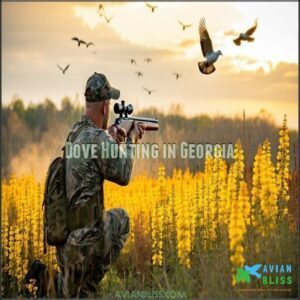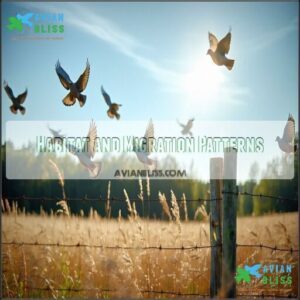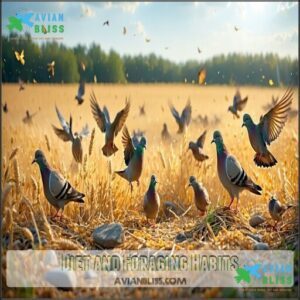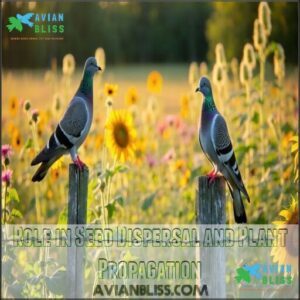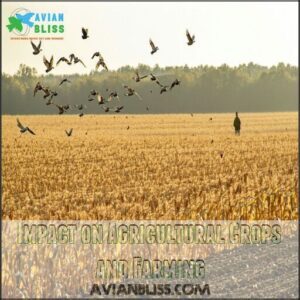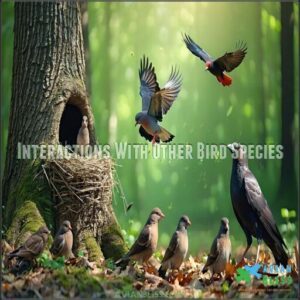This site is supported by our readers. We may earn a commission, at no cost to you, if you purchase through links.
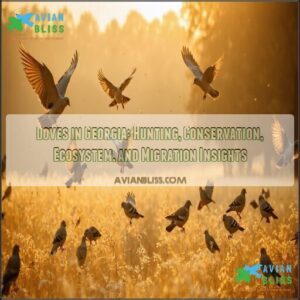
These graceful birds thrive in Georgia’s diverse habitats, from open fields to suburban areas.
Hunting season typically runs September through January, with specific regulations you’ll need to follow.
Doves in Georgia play essential ecological roles by dispersing seeds and serving as prey for larger predators.
You can attract them to your yard with black oil sunflower seeds and millet on ground feeders.
Their distinctive cooing sound forms part of Georgia’s natural soundtrack.
The relationship between these birds and Georgia’s landscape tells a fascinating story of adaptation and resilience.
Table Of Contents
- Key Takeaways
- Dove Hunting in Georgia
- Mourning Doves in Georgia
- Doves in Georgia’s Ecosystem
- Dove Management and Conservation
- Dove Hunting Culture in Georgia
- Frequently Asked Questions (FAQs)
- What kind of doves are in GA?
- Is it good to have doves in your yard?
- What are the rules for doves in Georgia?
- What kind of doves are in Georgia?
- Are doves good to have in your yard?
- What is the difference between a dove and a mourning dove?
- What does it mean when a mourning dove visits you?
- How long is dove season in Georgia?
- Are mourning doves good to have in your yard?
- Can you shoot doves in Georgia?
- Conclusion
Key Takeaways
- You’ll find two main dove species in Georgia – mourning doves and white-winged doves – which thrive in habitats ranging from open fields to suburban backyards.
- Georgia’s dove hunting season typically runs from September through January with specific regulations including a daily bag limit of 15 doves, requiring a hunting license and migratory bird stamp.
- Doves play essential ecological roles in Georgia’s ecosystem through seed dispersal, serving as prey for larger predators, and acting as indicators of environmental health.
- You can attract doves to your yard with black oil sunflower seeds and millet on ground feeders, where they’ll add their distinctive cooing sounds to your natural landscape.
Dove Hunting in Georgia
If you’re planning to hunt doves in Georgia, understanding the rules and best practices guarantees a successful and ethical experience.
From seasonal regulations to choosing the right gear, each step plays a role in conserving the bird population while enjoying this time-honored tradition.
Seasonal Regulations and Bag Limits
Georgia’s dove season offers three exciting phases, running from early September to late December.
Stick to the daily bag limit of 15 doves and a possession limit of 45. Don’t skip the essentials: a hunting license and migratory bird stamp.
Hunting starts half an hour before sunrise and ends at sunset.
For Eurasian Doves, there’s no bag limit and year-round hunting! Observing baiting regulations is vital for ethical hunting.
Following Georgia dove hunting regulations guarantees a sustainable, ethical experience while preserving populations for future hunts.
Best Hunting Locations and Times
Knowing the right spots and timing can make or break your dove hunting experience in Georgia.
The key lies in scouting the landscape and understanding dove behavior. Fields planted with sunflowers, millet, or corn are magnetic for doves, offering them an irresistible buffet. Public dove fields Georgia-managed provide excellent opportunities for those without private access.
Peak hours matter too. Early mornings and evenings, when birds move between roosting and feeding areas, are prime hunting times. Blending into woodland edges for natural cover improves your chances. Weather influence also plays a role—cooler mornings often bring more activity, so dress lightly but stay ready for action.
- Find agricultural fields featuring sunflowers and sorghum.
- Look for natural cover like tree lines and shrubs.
- Observe bird patterns days before dove season Georgia starts.
- Consider weather trends to determine activity spikes.
- Follow migration paths around best dove hunting spots.
Essential Gear and Equipment
The right hunting gear prepares you for success in dove hunting Georgia.
A reliable 12-gauge shotgun and proper ammunition types, like steel or lead shot, improve your accuracy.
Camouflage clothing helps you blend into the environment, while tough boots handle rugged terrain with ease.
A hunting blind adds cover, and decoy strategies can make wary doves land nearby.
Keep everything handy in a functional backpack and pack hearing protection.
For peak performance, consider the specifics of a dove hunting shotgun.
Don’t forget your hunting license.
Here’s a quick table for reference:
| Gear | Purpose | Example | Tip |
|---|---|---|---|
| Shotgun Selection | Accuracy | 12-gauge shotgun | Practice for smooth handling |
| Ammunition Types | Precision | Steel/Lead shot | Match size to hunting rules |
| Camouflage Clothing | Concealment | Camo jacket, gloves | Blend with local habitats |
| Hunting Backpack | Organization | Durable backpack | Keep items easy to access |
Hunting Techniques and Strategies
Successful dove hunting in Georgia is about combining smart tactics with careful preparation.
Picking the right field and setting up are half the battle. Scout dove fields in Georgia in advance, looking for flight paths, feeding areas, and watering spots.
- Decoy Placement: Set dove decoys near feeding zones or along natural flyways. Place a few spinning-wing decoys to mimic movement—they’re irresistible. Consider using realistic dove silhouettes to enhance your setup.
- Blind Concealment: Use shrubs, fences, or low natural cover for hiding. Stay concealed but maintain a clear shooting view.
- Shooting Techniques: Practice steady, fluid movements. Lead the bird in flight for accurate shots.
Calling techniques also help lure doves closer. These simple hunting techniques bring the action to you and make every outing productive.
Safety Precautions and Etiquette
Sharpen your skills by prioritizing safety and respect in Georgia’s dove fields. Stick to Firearm Safety basics: always aim your muzzle downrange and keep the safety on until you’re ready to shoot. Bright clothing isn’t just for style—it’s a lifesaver in ensuring proper Hunter Conduct and visibility.
Know your zone and respect others’ space to avoid accidents. Clear communication, like hand signals or quick calls, keeps everyone on the same page. Stay legal by following hunting laws and avoiding baited fields—getting fined ruins the fun fast.
Handling injured doves? Act quickly and humanely to uphold Ethical Hunting standards. Respect landowners by leaving fields clean and gates as you found them. Finally, brush up on hunter education and carry basic Field First-Aid gear. Enjoy the outdoors wisely and safely.
Mourning Doves in Georgia
You’ll find mourning doves all across Georgia, from open fields to suburban backyards, easily recognized by their soft gray-blue feathers and slender bodies.
These graceful birds are known for their gentle cooing calls and important role in the ecosystem through seed dispersal and providing prey for predators.
Physical Characteristics and Identification
When you’re birdwatching in Georgia, mourning doves stand out with a mix of elegance and subtlety.
Use this dove identification guide to spot them:
- Plumage Variations: Look for smooth gray-blue feathers with black wing spots and pale underparts.
- Size Comparison & Distinguishing Features: They’re slim, about 12 inches long, with long, tapered tails edged in white—visible mid-flight.
- Eye Color & Juvenile Identification: Adults flaunt a bright blue eye-ring, while juveniles are duller, lacking the same vibrance.
Perfect for mastering bird identification in Georgia!
Habitat and Migration Patterns
Doves in Georgia showcase remarkable adaptability in their habitat and migration patterns.
Some stay year-round, while others follow seasonal movements, responding to migration triggers like food availability and weather changes.
Mourning doves thrive in Georgia habitats such as open woodlands and farmland, favoring areas that guarantee ample breeding opportunities.
Dove migration in Georgia peaks during spring (April-May) and fall (August-November).
Along their journey, they often rely on coastal regions and suburban gardens as stopovers. However, habitat loss from urbanization and changing climates poses challenges to their survival.
White-winged doves adapt well to human-altered landscapes, a tribute to doves’ resilience. Seasonal movements highlight Georgia doves’ ability to balance environmental changes with instinctive routines.
Diet and Foraging Habits
Mourning Doves have feeding habits that showcase their adaptability.
They’re ground feeders with an eye for seeds and grains, often turning Georgia’s open fields into a natural buffet.
Their seed preferences lean toward sunflower, millet, and wheat, but these doves occasionally snack on small insects for a touch of protein.
They often forage in farmlands, grassy fields, or near water sources, where they also hydrate after meals.
To aid digestion, doves ingest small bits of grit, like sand or pebbles, which helps process tougher foods.
- Interesting Fact: Mourning Doves can eat up to 20% of their body weight in seeds daily, effectively balancing crop consumption and supporting energy for nesting.
Breeding and Nesting Behaviors
Mourning doves are breeding birds that thrive on teamwork.
They carefully choose nesting sites for safety and proximity to food. Their nests are simple twig platforms, designed for practicality.
With a clutch size of 2 eggs, parents share a 14-15 day incubation period, showcasing unmatched parental care and unity.
Once the chicks hatch, both parents feed them nutrient-rich crop milk.
| Aspect | Details | Fun Fact |
|---|---|---|
| Nesting Materials | Twigs and straw | Doves reuse nests! |
| Clutch Size | 2 eggs | Smallest among doves. |
| Incubation Period | 14-15 days | Both parents share. |
The doves’ parental care is a notable aspect of their behavior, and their ability to work together is essential for the survival of their young.
Conservation Status and Threats
Georgia’s mourning doves face significant challenges that make survival harder year after year.
Habitat loss due to urbanization shrinks their nesting and feeding grounds. Climate change brings unpredictable weather, affecting their migration and reproduction. Exposure to pesticides reduces food quality, while predators thrive in altered ecosystems. Wildlife diseases also pose a growing risk.
Despite these threats, dove conservation efforts in Georgia, including habitat restoration and population monitoring, provide hope. The Georgia DNR’s programs to track migratory patterns play a vital role in preserving these birds.
- **Did You Know?
**Habitat loss and pesticide impact are key challenges facing mourning doves, yet conservation initiatives aim to reverse these trends.
Doves in Georgia’s Ecosystem
You’ll find doves in Georgia playing essential roles in the ecosystem, from spreading seeds that help plants grow to serving as prey for predators like hawks and owls.
Their behaviors also provide clues about environmental health, making them essential indicators for scientists and conservationists, and their presence can signal the overall ecosystem balance.
Role in Seed Dispersal and Plant Propagation
You’ve probably never thought of birds as gardeners, but that’s exactly what doves are.
Using their seed dispersal methods, they munch on seeds, grains, and fruits, then unknowingly plant them in new areas through digestion and travel.
This act keeps plant species thriving, restoring habitats and enriching biodiversity. By delivering seeds to fresh soil, doves provide ecosystem services that benefit all life.
Their role in plant propagation reveals unique conservation implications and reminds us how small actions sustain Georgia’s green balance.
Doves consume a variety of seeds, and sunflower seeds are favored at bird feeders, which is a key part of their seed dispersal methods and supports the overall plant species.
Importance as Prey for Larger Predators
Georgia’s skies are a stage where predator-prey relationships play out daily, keeping the ecosystem in balance.
Birds of prey, like hawks and owls, rely on doves as a key part of their diet, showcasing the food web dynamics that sustain nature.
These dove-predator interactions help control dove populations naturally while supporting predator survival.
Without doves in Georgia, predator populations would struggle, and ecosystem balance could falter.
- **Predators thrive on doves for survival.
- **Doves support ecosystem stability.
- **Food web dynamics rely on this link.
- **Hawks depend on this essential prey.
- **Georgia wildlife flourishes with balance.
Impact on Agricultural Crops and Farming
Fields teeming with grain can feel like an open invitation to doves, but their seed consumption sometimes leads to crop damage for Georgia’s farmers.
Scattering scare tactics—like using decoys or carefully timing harvests—helps curb crop loss while staying eco-friendly. Thoughtful habitat modification, such as leaving grain strips untouched, can also shift doves’ focus to specific areas.
Notably, their droppings act like free fertilizer, benefiting the soil. With strategic farming practices, you can balance minimizing crop pests while supporting essential dove conservation efforts that benefit farming ecosystems.
Hunters are encouraged to report banded birds to aid in understanding dove movement.
Interactions With Other Bird Species
In Georgia’s bird habitats, doves interact with various bird species, traversing habitat overlap and competition for resources like nesting sites.
They face predator-prey dynamics with hawks, where agility often determines survival.
Symbiotic relationships emerge as they share ecosystems, while encounters with invasive bird species add complexity.
Disease transmission also plays a role, highlighting the delicate balance of Georgia’s bird ecology.
Indicators of Environmental Health
When you watch doves, you’re getting a glimpse into the health of Georgia’s ecosystem.
These birds don’t just flutter around aimlessly—they’re environmental barometers, showcasing how things are going for local habitats and wildlife.
Changes in dove health often spotlight bigger ecological problems.
Here’s what to watch for:
- Fluctuating numbers: Declines in Georgia bird species can signal habitat quality issues.
- Altered migration paths: These shifts may reflect climate change or lost resources.
- Nesting struggles: Failed reproduction hints at poor habitat quality and pesticide impact.
- Limited seed diversity: A shrinking food base affects their survival.
- Fewer dove varieties: Biodiversity loss echoes larger environmental health concerns.
Doves in Georgia serve as quiet yet powerful messengers for nature’s balance.
Dove Management and Conservation
You play a key role in managing and conserving Georgia’s dove populations by supporting habitat restoration and following responsible hunting practices.
These efforts guarantee healthy ecosystems and sustainable populations, benefiting both the environment and future generations.
You are contributing to a crucial cause by ensuring healthy ecosystems through your actions.
Habitat Preservation and Restoration
Ever wonder how habitat restoration changes everything? Focus on native plants to revive habitats and give doves food and shelter.
Restoring native bird habitats with wildflowers and grass supports biodiversity, while preserving nesting sites prevents population drops. Protecting water sources, like small wetlands, guarantees doves have feeding grounds in migratory and urban habitats.
Here’s a quick breakdown:
| Action | Dove Benefit |
|---|---|
| Native Plants | Food, shelter |
| Preserve Nesting | Boosts breeding |
| Protect Wetlands | Provides water |
Each step supports dove conservation in Georgia. Think of it as turning your backyard, field, or nearby protected areas into a sanctuary for life to thrive.
Population Monitoring and Research
Georgia’s skies reveal intriguing clues about dove population dynamics through precise monitoring and research.
Detailed surveys, banding studies, and data analysis give scientists insights into their movement and survival.
- Survey Techniques locate doves’ habitats and counts across Georgia.
- Banding Studies track migration and lifespan patterns.
- Habitat Impact Monitoring evaluates changes affecting populations.
- Disease Prevalence Research guarantees health and stability.
- Genetic Diversity Analysis safeguards species resilience.
These tools keep dove populations healthy, guaranteeing they remain essential to Georgia’s ecosystem and traditions, enriching both science and local culture.
Hunting Regulations and Enforcement
Getting a dove hunting license and following hunting regulations is key for legal success.
The Georgia DNR sets rules like bag limits of 15 per day, approved hunting hours, and legal methods (shotguns only).
Wildlife officers enforce laws strictly—penalties await violators.
Protecting doves also involves habitat restoration efforts.
Stick to ethical hunting practices to preserve Georgia’s traditions and keep hunting both fun and sustainable!
Education and Outreach Programs
Protecting doves in Georgia begins with education and outreach.
By joining these programs, you can help safeguard these essential birds while having a little fun:
- Explore Conservation Workshops hosted by Georgia DNR to learn about habitat preservation and dove biology.
- Participate in Citizen Science Projects like migration tracking to gather data alongside fellow bird enthusiasts.
- Enroll kids in School Programs fostering dove conservation with hands-on activities and wildlife education.
- Boost Public Awareness by attending Georgia wildlife festivals or promoting bird conservation education events in your community.
Small steps create big changes!
Collaborative Conservation Efforts
Collaborative dove conservation efforts in Georgia start with teamwork.
Groups like Georgia DNR lead research funding and habitat restoration, while bird conservation organizations engage in public education and policy advocacy.
Hunters, as active participants, report banded doves and share local insights.
Community engagement strengthens these efforts, linking people with native bird conservation efforts.
Small actions, like joining restoration projects, show how working together transforms Georgia’s landscapes, creating safe havens for doves and ensuring these birds remain part of Georgia’s rich ecosystem.
Dove Hunting Culture in Georgia
You’ll find that dove hunting in Georgia is more than a pastime—it’s a long-standing tradition that brings people together.
With a mix of historical roots, community events, and shared experiences, it embodies a unique blend of culture and conservation.
History and Tradition of Dove Hunting
Dove hunting in Georgia weaves a tapestry of Early Hunting Practices and shared Cultural Significance.
From the handcrafted tools of the past to today’s advancements, the Hunting Evolution shaped traditions passed down generations.
Georgia’s fields echo stories of perseverance, marking the hunt as a rite of passage.
Historical Regulations have preserved these customs, ensuring sustainability through the Georgia DNR doves program.
This cherished practice isn’t just about game—it’s about storytelling, skill, and honoring heritage.
For thoughtful participation, here’s one tip: master time-tested tactics like silent setups and respectful conduct.
Each hunt links you to history, ensuring the spirit of dove hunting Georgia lives on.
Community Events and Festivals
Dove festivals in Georgia beautifully blend hunting traditions with community gatherings.
These colorful events spotlight local economies, featuring wildlife education booths, dove-themed art, and birdwatching activities.
Cookoffs steal the show, letting families and hunters swap recipes while savoring creative dove dishes. Kids enjoy youth involvement through fun conservation awareness activities.
Festivals also include conservation drives, creating a space where protecting wildlife meets celebration. Between delicious food and shared stories, these community events foster belonging and honor Georgia’s love for its doves.
These festivals often highlight the importance of grit in dove digestion, which is a key aspect of dove digestion.
Hunting Clubs and Organizations
Hunting clubs in Georgia are like a backstage pass to the realm of dove hunting.
They connect you to experienced hunters, valuable resources, and exclusive land access, shaping skills and building a strong conservation-minded community.
These clubs don’t just focus on great hunts—they emphasize protecting Georgia’s dove habitats and supporting ethical practices.
Membership often includes youth programs, offering kids a hands-on intro to dove hunting and wildlife care.
Clubs also team up with landowners to maintain dove fields in Georgia, ensuring members can enjoy private dove hunting with proper landowner permission.
- Bonus: Many clubs offer mentorship programs and conservation-focused projects, blending tradition and sustainability.
Joining builds camaraderie and a sense of belonging while nurturing your love for outdoor traditions.
Recipes and Cooking Techniques
Moving from hunting clubs to the kitchen, you’ll find numerous ways to prepare your harvest after a successful day in the field.
Georgia hunters have developed delicious dove recipes that showcase this game bird’s unique flavor.
Transform your dove breasts into mouthwatering bacon-wrapped grilled dove by stuffing them with a savory mix of celery, onion, and parsley sautéed in butter.
For a simpler approach, try dove nuggets – just bread the breasts with flour, salt, pepper, and sazon before frying.
When you’ve got time, slow-cooked dove creates tender meat that falls off the bone.
Place birds in a crock pot with hot gravy and Vidalia onions, then cook on high for 2.5 hours.
Some cooks prefer to purchase related products to enhance their dishes.
For special occasions, huckleberry grilled doves offer a sweet-savory contrast that keeps the meat pink inside while crisping the skin.
The classic dove and dumplings remains a comfort food favorite throughout Georgia.
Frequently Asked Questions (FAQs)
What kind of doves are in GA?
Like feathers on the wind, you’ll find five main species in Georgia: Mourning Doves, Common Ground Doves, White-winged Doves, Eurasian Collared-Doves, and Rock Pigeons.
Each has unique markings and habitats throughout the state, making Georgia a diverse place for these species.
Is it good to have doves in your yard?
Having doves in your yard is beneficial as they help with seed dispersal, add pleasant cooing sounds to your environment, and don’t typically damage plants or structures.
They’re also peaceful visitors that symbolize tranquility.
What are the rules for doves in Georgia?
Georgia enforces specific regulations for doves including hunting seasons (September-January), bag limits (15 per day), and licensing requirements.
You’ll need a hunting license and migratory bird stamp if you’re planning to hunt these birds.
What kind of doves are in Georgia?
You’ll find five main species in Georgia: Mourning Doves, Common Ground Doves, White-winged Doves, Eurasian Collared-Doves, and Rock Pigeons. Each has distinctive markings and habitats throughout the state.
Are doves good to have in your yard?
Yes, you’ll benefit from having doves in your yard. They’re peaceful visitors that help with seed dispersal, provide gentle cooing sounds, and don’t typically cause damage to plants or property.
What is the difference between a dove and a mourning dove?
A mourning dove is a specific species (Zenaida macroura) with grayish-blue plumage, slender body, long tail, and red eyes.
It’s just one type among several dove species found throughout North America.
What does it mean when a mourning dove visits you?
When a mourning dove visits you, it’s often seen as a sign of peace or spiritual connection. These gentle birds may simply be seeking food or shelter in your yard.
How long is dove season in Georgia?
In Georgia, you’ll find dove season runs from September to January, with three distinct phases. The 2024 season includes September 7-October 13, November 23-December 1, and December 19-January
Are mourning doves good to have in your yard?
Having mourning doves in your yard is beneficial as they consume weed seeds, add gentle cooing sounds to your environment, and don’t damage plants or structures.
They’re peaceful visitors that enhance backyard biodiversity.
Can you shoot doves in Georgia?
Like clockwork in autumn fields, you can shoot doves in Georgia during the three-phase hunting season from September through January.
You’ll need a hunting license and migratory bird stamp, with a 15-dove daily limit.
Conclusion
Whether you’re a dedicated hunter or passionate birdwatcher, doves in Georgia offer something for everyone.
From the soft cooing of mourning doves at dawn to the strategic challenges of hunting season, these birds connect you to Georgia’s natural heritage.
By understanding their ecological importance and supporting conservation efforts, you’ll help guarantee future generations can enjoy these graceful creatures.
Next time you spot a dove in flight, remember you’re witnessing a key part of Georgia’s diverse ecosystem.
- https://birdwatchinghq.com/doves-that-live-in-georgia/
- https://site.extension.uga.edu/lincoln/dove-management-in-georgia/
- https://huntwise.com/field-guide/small-game/your-guide-to-the-2024-dove-season-georgia
- https://gastateparks.org/georgia-dove-hunting-season-opens-sat-sept-7
- https://georgiawildlife.com/out-my-backdoor-doves-arent-great-nest-builders

